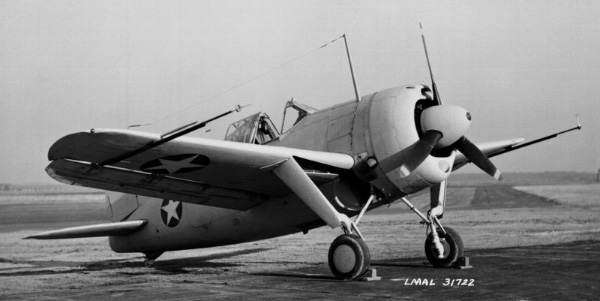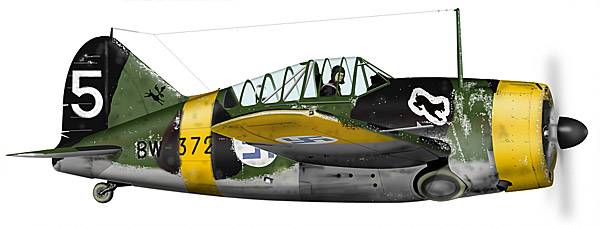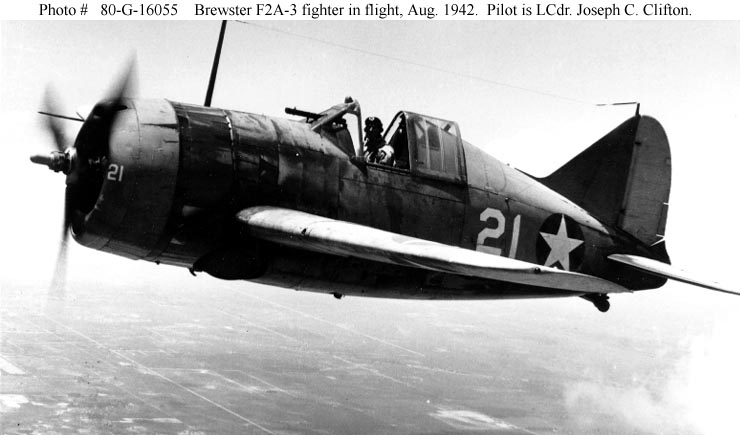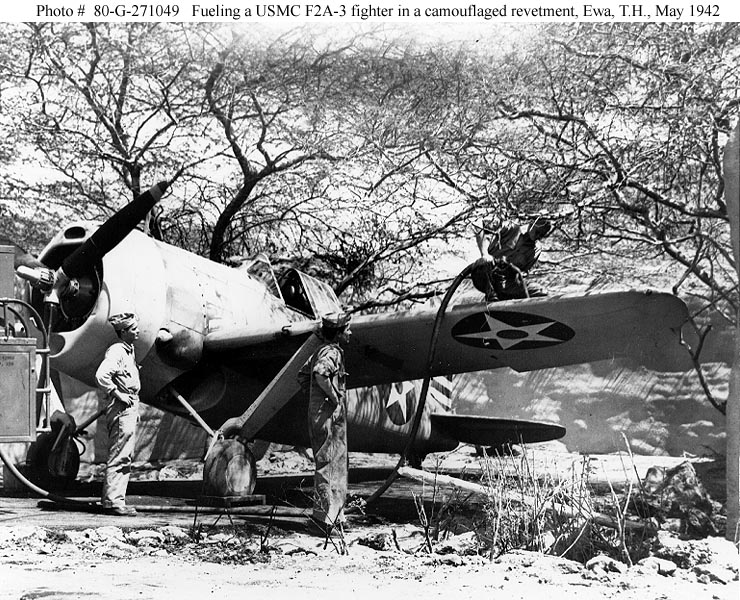
|
 |
Brewster F2A Buffalo |
 |
 |
 |
 |
 |
|---|---|---|---|---|---|---|---|
 |
 |
 |
 |
 |
|||
 |
||
|
The first monoplane fighter to enter service with the US Navy was designed and built by a company which had only ventured into the aviation industry in 1932. Nevertheless, the company's two design engineers, Dayton T. Brown and R.D. MacCart proved that their ideas on monoplane design were ahead of the pack. On November 15, 1935, the US Navy issued a requirement to replace the
Grumman F3F biplane, with an aircraft capable of 300 mph (483km/h). Only three companies applied: Seversky with the XFN-1, a navalized version of the P-35; Grumman with the XF4F-1 biplane; and Brewster with an entirely new design. On February 2, 1936, the Navy ordered a prototype of the Grumman biplane, but it was never built. Grumman realized that the era of biplane fighters was over. On June 22, 1936, the US Navy ordered a prototype of the Model B-139 from Brewster which was designated the F2A, assigning the fledgling company the letter A, which had previously denoted General Aviation (ex Atlantic).
Brewster's new airplane was an all-metal cantilever mid-wing monoplane with a stubby fuselage and fabric-covered flight controls. It had split-flaps that were hydraulically controlled. It had an enclosed cockpit and a fully retractable landing gear with a tail wheel and arrester hook for carrier landings. It was powered by a 950 hp (708 kW) Wright R-1820-22 Cyclone engine driving a metal three-blade Hamilton propeller. Armament consisted of one M2 Browning .50 caliber machine gun with 200 rounds and one Browning .30 caliber machine gun with 600 rounds—both located in the nose. Service testing began in January 1938, and early test flights on the Model B-139 did not meet the 300 mph requirement, but after wind tunnel tests and corrections to the cowling and engine intakes, the plane reached 304 mph (482 km/h), and had an impressive initial rate of climb of 2,750 ft/min. It was also praised for its good turning and maneuvering abilities. The Navy therefore ordered a first series production run of 54 aircraft, on June 11, 1938, while reserving judgment on Grumman's XF4F-2 monoplane fighter.

43 aircraft of the first US Navy order of F2A-1s were sent to Finland. |
| Production facilities at Brewster were wholly inadequate and deliveries of aircraft were slow. Of the first batch of 54 aircraft ordered, the US Navy took delivery of only eleven F2A-1s. The remainder of the order was delivered to the Finnish Air Regiment LeR2 which was fighting a desperate defensive battle against the Soviet Union. In 1939, an upgraded F2A-2 with a more powerful engine and other changes became available and these were ordered to replace the F2A-1s. In June 1940, VF-3 Fighter Squadron aboard the aircraft carrier USS Saratoga became the first squadron to receive the Navy's first carrier-borne monoplane fighters.1 |
| In 1940, orders started to reach Brewster from European purchasers: 40 B-339s for Belgium; 170 B-339Es series for Great Britain; 72 B-339Ds and 20 of the B-439 variant (with the more powerful 1,200 hp engine instead of the 1,100 hp model) for the Netherlands East Indies Air Force. Brewster's factory was working at full stretch during the early months of 1940 but serious problems arose during the second half of that year. The most alarming was the US Navy discovered that the F2A's landing gear was not strong enough to stand up to flight deck landings, even when these were smooth and slow. The second came when the RAF reported from Britain that the Buffalo, as it had been called, fell short of contemporary European fighter performance; the third set back stemmed from requests for more armor protection from European buyers and from the US Navy (for the F2A-3). This led to an increase in weight and adversely affected the plane's performance: it now suffered from instability and was difficult to handle. There was no easy way of solving these faults: the landing gear had its two weaker struts strengthened but no further improvement was possible without completely redesigning the whole aircraft. |
 |
|---|
|
A more powerful Pratt Whitney engine could not be substituted for the Wright engine as it
was much larger and longer, making a rebuild necessary. While all this
was going on, the Grumman F4F-3 was scoring top marks and it was
obvious that once the current production run had ended (making a total
of 507 F2As built), no more would follow. One other US Navy
Squadron, apart from VF-3 aboard USS Saratoga received F2A-2s:
VF-2 of USS Lexington which only flew them from September 1941
until January 1942. All the Navy's F2A-2s and F2A-3s were accordingly
ceded to the Marine Corps, where they saw service with VFM-221
Squadron from land bases and first saw action in the Battle of Midway on June 4, 1942, suffering very heavy losses indeed. Of the 25 aircraft that went into action (19 F2As and 6 F4Fs) only 7 survived (6
F2As and 1 F4F). The F2A was simply no match for the
Japanese Zero fighters or Nakajima Ki-43 Oscar.
Other pilots of the Royal Netherlands East Indies Army Air Corps and Royal Air Force had already paid the price for the Buffalo's shortcomings well before this in the Far East. The first F2As to arrive in Britain were aircraft which should have gone to Belgium, but was then occupied. These were flown by 805th and 885th Squadrons of the Fleet Air Arm and took part in the defense of Crete, but not as front line aircraft. Once 71st Squadron of the RAF found how inferior their B-339Es were to the Spitfires and Hurricanes, the Buffaloes were shipped off to Squadrons serving in the Far East: 67th (Burma) and 243rd (Singapore), both RAF; 21st (Malaya) and 453rd (Singapore), Royal Australian Air Force and 488th Squadron of the Royal New Zealander Air Force based in Singapore. All these bases were overwhelmed in the tidal wave of the Japanese invasion and the Buffaloes were literally blown to bits. |
 |
|---|
|
In March 1941, the few remaining serviceable aircraft were being flown by 146th Squadron and the
American Volunteer Group in Burma, but not for long. Other Buffalo
users stationed in the Far East fared no better. The B-339Ds of 1-VLG
V, 2-VLG V, 3-VLG V and 3-VLG IV of the Royal Netherlands East
Indies Army Air Corps were decimated as they tried to defend Java,
Sumatra, Malaya and Borneo. By the time Java fell, only four, unserviceable B-339Ds were left on the airfield, all the others had been destroyed, although they had managed to score victories against
Japanese aircraft. When the Brewster fighter engaged the Japanese
fighters it was out of its league, but it was more a matter of being outclassed rather than a poor design. This was demonstrated when 44 Buffaloes (43 F2A-1s and the plane which had been the XF2A-1) that served with the Finnish Ilmavoimien (flown by LLv21, LLv22, LLv24 and LLv26 Squadrons) held their own against the Soviet warplanes until
1944, when they were replaced by Messerschmitt Bf-109s.
Einno Lunkkanen, the Finnish ace, achieved most of his "kills" in his F2A. Finnish Air Force records show 41 victories to a single F2A credit before it was shot down. The Soviet Air Force was equipped with second-rate fighters and gave the F2A a chance to shine. When compared with the German, British and Japanese combat planes the Brewster came out last. The last surviving Brewster F2A in Finland made its final flight on September 14, 1948, but by then the Brewster Aeronautical Corporation itself was no more. |
| Specifications: | |
|---|---|
| Brewster F2A-3 Buffalo | |
| Dimensions: | |
| Wing span: | 35 ft 0 in (10.67 m) |
| Length: | 26 ft 4 in (8.03 m) |
| Height: | 12 ft 0 in (3.66 m) |
| Weights: | |
| Empty: | 4,732 lb (2,146 kg) |
| Max Takeoff: | 7,159 lb (3,247 kg) |
| Performance: | |
| Maximum Speed: | 321 mph (517 km/h) at 16,000 ft (4,877 m) |
| Cruise Speed: | 161 mph (259 km/h) |
| Service Ceiling: | 33,200 ft (10,119 m) |
| Normal Range: | 965 miles (1,553 km) |
| Powerplant: | |
| One 1,200 hp (890 kW) Wright R-1820-40 Cyclone radial engine. | |
| Armament: | |
|
Two .50 caliber nose machine-guns. Two .50 caliber wing machine-guns. | |
Endnotes:
|
1. David Mondey. The Concise Guide to American Aircraft of World War II. New York: Smithmark Publishers, 1982. 42. |
© The Aviation History On-line Museum
All rights reserved.
Created November 15, 2006. Updated October 17, 2013.